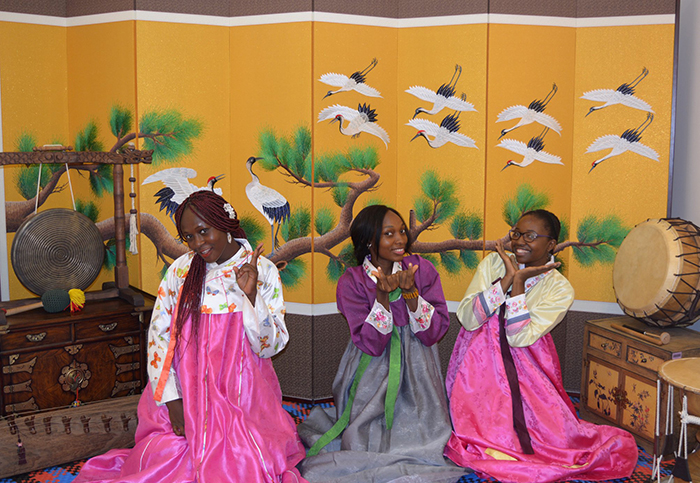View this article in another language
- 한국어
- English
- 日本語
- 中文
- العربية
- Español
- Français
- Deutsch
- Pусский
- Tiếng Việt
- Indonesian

The Korean Cultural Center in Nigeria provides a chance for Nigerians to learn about Korean heritage and traditions.
By Korea.net Honorary Reporter Edward Olivet Chiamaka from Nigeria
Photos = Korean Cultural Center in Nigeria
Time travel has been achieved in Nigeria on the monthly Korean Culture day at the Korean Cultural Center in Nigeria, located in the capital Abuja. This past April, some 50 guests were transported back to Joseon times. It was very educational, as the guests learnt a lot about ancient life in Joseon times, which was a very important era in Korean history, especially in terms of the language and clothing.
Different outfits worn during those days, including styles only worn by the royal family, were on display and even modeled during a simulation of life in this period. There was a presentation by Rabbiatu Bobboi, after which the various outfits were described and put on display. After the presentation and photos, guests were treated to some delicious Korean and Nigerian snacks.
Let’s learn a little about the clothes worn in Joseon times. The overall style is called Hanbok. Hanbok attire is the traditional Korean style of clothing, and the word is used to describe both men's and women's outfits. For women, Hanbok consists of two main parts, jeogori blouse-like top and the chima skirt-like bottom part. While for the men, they also have a jeogori, but it's usually longer and it's paired with a baji, a type of loose-fitting pants. The fabric and colors depend on the social status and social position of the wearer. The exhibit focused especially on the various types of Hanbok worn by the royal Joseon family.
The king's most common daily attire was the hongryongpo or gonryongpo, a red robe with large round embroidered emblems of dragons sewn onto it. It was worn along with a crown called an ikseonggwan and a waist belt out of jade called a gakde. There were other pieces of attire worn by the king during special occasions, like weddings, coronations, religious rites, and so on. For example, during religious rites, the king would wear a piece of clothing called a myeonbok.

Visitors try on some traditional Hanbok attire and pose for a photo at the Korean Cultural Center in Nigeria.
The most common and daily item worn by female members of the royal family were called dangui, a form of jeogori. They were characterized by a shaped front and back lower parts, like part of a circle with pointed ends. For the royal princesses and consorts, a geumbak or gold leaf patterns were embroidered onto the dangui and chima skirt, while for the queen, dragon emblems were sewn onto the dangui on the shoulders and front, similar to the king’s. During special occasions, other items of clothes, like the wonsam ceremonial overcoat, the hwal-ot, usually worn by princesses when they are getting married, and other items were worn.
The crown prince also wore a hongryongpo like the king, but it was usually blue and the dragons embroidered on it were lesser-toed dragons than the king’s dragons. Ordinary princes had different robes from the crown prince. They wore a round-necked robe similar to what government officials wore, with the colors and embroidered patterns being different.
From the fashion of that time, the guests were also taught a bit about the language style of that time. Modern Korean has evolved from that time, but the Joseon language is still the foundation for modern Korean.
We also learned some of the more interesting words used during Joseon times.
Aba mama: Father, used by a royal child to address his father, the king.
Eoma mama: Mother, used by a royal child to address his mother, the queen.
Jiabi/ Seobang/ Nanggun: Husband, used by wives to refer to their husbands.
Orabeoni/ Orabi: Older brother, used by younger women.
wisdom117@korea.kr
* This article is written by a Korea.net Honorary Reporter. Our group of Honorary Reporters are from all around the world, and they share with Korea.net their love and passion for all things Korean.